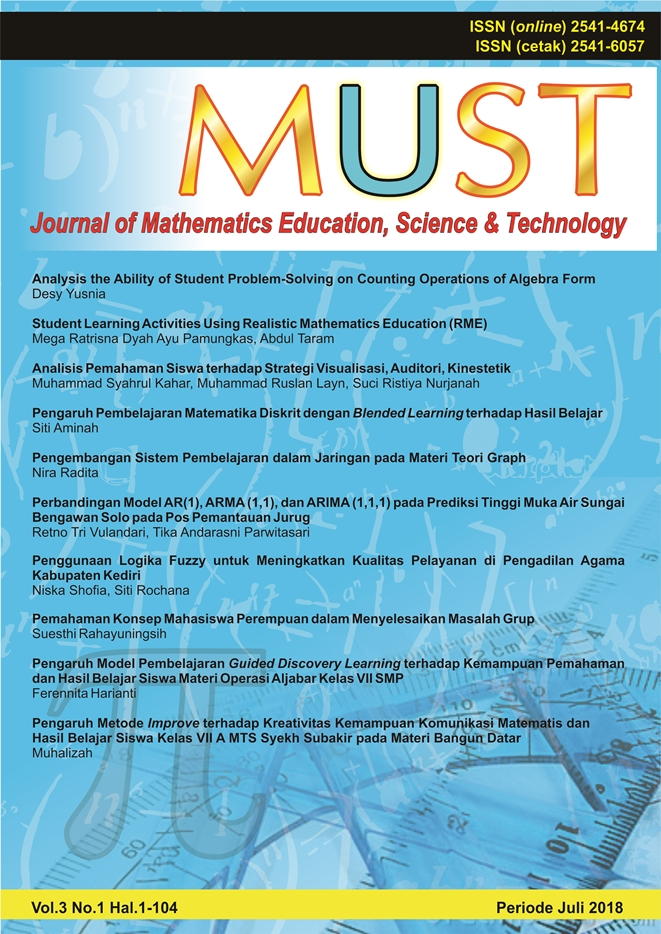Student Learning Activities Using Realistic Mathematics Education (RME)
Abstrak
The aims of this research is to increase student activity in learning mathematics by using Realistic Mathematics Education (RME) Â in class VIII SMP Muhammadiyah 2 Prambanan. The study was conducted two siklus. Data collection techniques used are observation, interview, documentation and triangulation. Instrument research observation sheet and interview. Instrument analysis using content validity. The analysis used is descriptive qualitative. The results showed that Realistic Mathematics Education (RME) can increase student learning activity This is evident from the observation of student activity in learning every siklus has increased, that is average of observation percentage of student activity in siklus I 50,623% (enough), and at siklus II increased to 61.960% (good). From the results of interviews with students showed a positive response on student learning activity.
Â
Artikel teks lengkap
Referensi
Adhia, Hana. 2015. Peningkatan Aktivitas Belajar Matematika Siswa Kelas XII TKR SMK Adzkia Padang Dengan Model STAD. Jurnal LEMMA Volume 2, Nomor 2, November 2015.
Aisyah, Siti. 2015. Meningkatkan Aktivitas Belajar Siswa dengan Menerapkan Kolaborasi Pembelajaran Kolaboratif. Jurnal Pendidikan Bisnis dan Managemen Volume 1, Nomor 1, Juli 2015.
Aldila, Ekasatya. 2016. Makna Realistic dalam PMRI dan RME. Jurnal LEMMA Volume 2, Nomor 2, Maret 2016, ISSN: 96 - 104
Kenan. 2014. Upaya Peningkatan Aktivitas Belajar Siswa Melalui Penerapan Metode Penguasaan Pada Materi Pokok Menulis Di Kelas IV SD Negeri 0506-49 Simpang Pulau Rambung. Jurnal Saintech Volume 6, Nomor 2, Juni 2014, ISSN: 2086-9681.
Kurniawan, Fajar & Nining. 2016. Analisis Lembar Kerja Siswa Mata Pelajaran Matematika Ditinjau Dai Taksonomi Bloom Revisi. Publikasi Ilmiah. Universitas Muhammadiyah surakarta : Surakarta.
Muchlis, Effie Efrida. 2012. Pengaruh Pendekatan Pendidikan Matematika Realistik Indonesia (PMRI) Terhadap Perkembangan Kemampuan Pemecahan Masalah Siswa Kelas II di SD Kartika 1.10 Padang. Jurnal Exacta Volume 5, Nomor 2, Desember 2012, ISSN: 1412 – 3617.
Muhtadi, Dedi & Sukirman. 2017. Implementasi PMRI Untuk Meningkatkan Kemampuan Berfikir Kreatif Matematik Dan Kemandirian Belajar Paserta Didik. Jurnal Mosharafa Volume 6, Nomor 1, Januari 2017, p-ISSN: 2086-4280, e-ISSN: 2527-8827.
Raharjo, Joko. 2014. Peningkatan Aktivitas Belajar Matematika dengan Penerapan Metode Problem Posing Tipe Post Solution Posing. Naskah Publikasi. Universitas Muhammadiyah Surakarta : Surakarta.
Sembiring, Robert. 2010. Pendidikan Matematika Realistik Indonesia (PMRI) : Perkembangan Dan Tantanganya.Jurnal IndoMS. J.M.E Volume 1, Nomor 1, juli 2010, pp.11-16.
Sulistiowati, Evi. 2011. Pendekatan Matematika Realistik Untuk Meningkatkan Kemampuan Berfikir Siswa Ditingkat Sekolah Dasar. Jurnal Edisi Khusus Nomor 2, Agustus 2011, ISSN: 1412-565X
Syarifuddin, Ahmad. 2011. Penerapan Model Pembelajaran Cooperative Belajar Dan Faktor-Faktor Yang Mempengaruhi. Jurnal Ta’dib Volume 16, Nomor 1, Juni 2011.
Tarigan, Daitin. 2014. Meningkatkan Aktivitas Belajar Siswa Dengan Menggunakan Model Make A Match Pada Mata Pelajaran Matematika Di Kelas V SDN 050687 Sawit Seberang. Jurnal Kreano Volume 5, Nomor 2, Juni 2014, ISSN: 2086-2334.
Penulis
Penulis yang menerbitkan artikel di Jurnal MUST menyetujui persyaratan berikut:
Penulis memiliki hak cipta dan memberikan hak publikasi pertama kepada Jurnal MUST dengan karya yang secara simultan dilisensikan di bawah Creative Commons Attribution-NonCommercial 4.0 International License yang memungkinkan orang lain untuk berbagi karya dengan pengakuan kepengarangan karya dan publikasi awal dalam Jurnal MUST.
Penulis dapat mengadakan perjanjian kontrak tambahan yang terpisah untuk distribusi non-eksklusif versi jurnal yang diterbitkan dari karya tersebut (misalnya, mempostingnya ke repositori institusional atau menerbitkannya dalam sebuah buku), dengan pengakuan atas publikasi awalnya di Jurnal MUST.
Penulis diizinkan dan didorong untuk memposting pekerjaan mereka secara online (misal dalam repositori institusional atau di situs web mereka) sebelum dan selama proses pengiriman, karena dapat menyebabkan pertukaran yang produktif, serta kutipan yang lebih awal dan lebih besar dari karya yang diterbitkan.

